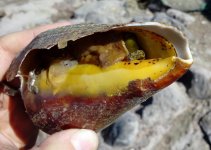Sure thing
StarryPearl and Yes: the
Argopecten (and also that of genus
Pecten) abductor muscle is what is usually refered to as the "scallop" for God know what reason. The one you are most used to is
Argopecten irradians from the Atlantic coast of the United States.
On this photo its primitive "eyes" (ocelli) look like pearls...don't they?
Why did we attempt to use them to grow pearls...because we could. We had the animals, we had time on our hands and with every experiment I learned more and more...I attuned myself as an instrument to
deeply understand the animals. And I did leanr many things, one is that you should NEVER try to produce pearls inside the abductor muscle, and never in the scallop's gonads. I actually believed that because the gonad of a scallop are "conspicuous" (separate from the rest of the body and very evident) I could produce pearls there with almost no rejection and almost zero mortality rates. I know that if I had tried for longer I could have made progress there...but I had to focus on the species that was producing pearls: the Rainbow Lip!
And even if the pearls are non-nacreous (in those days we just called them "calcium concretions") they had their own personality...specially the pearls of the Lion's Paw scallop (
Nodipecten subnudosus). I have some pearls and they are quite unique! This one is bi-colored.
They have this unique "pattern" that is mesmerizing in its own way.
The mantle selection criteria was very very simple at that moment...if it has mantle: let's use it!

It mattered little if the shell was white or purple...the only real criterion was: it has to be a healthy donor and the shell must be "clean" without spots or defects.
So, for me at least at that time in my life it was all about LEARNING all I could from these primitive and amazing mollusks so I could eventually perform the best job possible in the most humane way.


